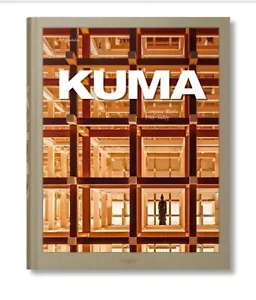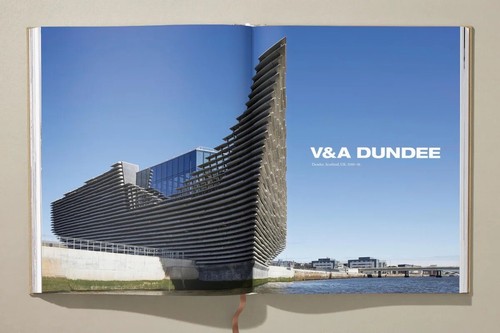Picture 1 of 17

















Gallery
Picture 1 of 17

















Have one to sell?
Kuma. Complete Works 1988 - Today. 2021 Ed by Philip Jodidio (English) HUGE Book
US $180.00
ApproximatelyRM 762.62
Condition:
Brand New
A new, unread, unused book in perfect condition with no missing or damaged pages.
2 available
Oops! Looks like we're having trouble connecting to our server.
Refresh your browser window to try again.
Shipping:
US $12.72 (approx RM 53.89) USPS Media MailTM.
Located in: Wichita, Kansas, United States
Delivery:
Estimated between Fri, 8 Aug and Thu, 14 Aug to 94104
Returns:
No returns accepted.
Coverage:
Read item description or contact seller for details. See all detailsSee all details on coverage
(Not eligible for eBay purchase protection programmes)
Seller assumes all responsibility for this listing.
eBay item number:226599133839
Item specifics
- Condition
- Brand New: A new, unread, unused book in perfect condition with no missing or damaged pages. See all condition definitionsopens in a new window or tab
- Type
- Does not apply
- ISBN-13
- 9783836575126
- ISBN
- 9783836575126
About this product
Product Identifiers
Publisher
Taschen
ISBN-10
3836575124
ISBN-13
9783836575126
eBay Product ID (ePID)
21038632128
Product Key Features
Book Title
Kuma. Complete Works 1988-Today. 2021 Edition
Number of Pages
460 Pages
Language
English
Topic
Individual Architects & Firms / Monographs, History / Contemporary (1945-), General
Publication Year
2021
Illustrator
Kuma, Kengo., Yes
Genre
Architecture
Format
Hardcover
Dimensions
Item Height
2.3 in
Item Weight
192.4 Oz
Item Length
18.4 in
Item Width
13.6 in
Additional Product Features
Intended Audience
Trade
LCCN
2022-389402
Dewey Edition
23
Reviews
For the past 30 years, I have been driven to create architecture by the desire to recover materials, and to reconnect people and physical things. It turned out to be the most enjoyable experience imaginable. This is because the world itself is material., A richly illustrated overview of Kuma's oeuvre that delves into his complete archive of built landmarks across the globe., This immense architectural tome establishes once and for all that sustainability and style need not be set at odds., Through descriptions, elevation drawings, sketches, and photographs, the architect's signature texture seems to jump off the page.
Dewey Decimal
720.92
Edition Description
Multilanguage edition
Synopsis
After Tadao Ando, Toyo Ito, and Fumihiko Maki, Kengo Kuma has breathed renewed vigor and lightness into Japanese architecture . Departing from the modernist skyscraper of the 20th century, Kuma traveled through his native Japan to develop a truly sustainable approach, translating local craftsmanship and resources into site-specific, timely buildings. Informed by tradition, and with both feet firmly planted in the present, this "materialist" heralds a new tactile architecture marked by its engaging surfaces , innovative structures , and fluid forms , reconnecting people with the physicality of a house . Kuma's objective, above all else, is "just to respect the culture and environment of the place where I am working." To this end, Kuma shaped the China Academy of Art's Folk Art Museum partially from discarded roof tiles; created a Chapel out of birch and moss in Nagano; and worked with local craftsmen to sculpt the V&A Dundee into a twisted, layered reflection of the Scottish coastal cliffs. With an extraordinary sensitivity for space, light, and texture, Kuma reveals unexpected qualities in materials, finding the weightlessness of stone in Chokkura Plaza and the softness of aluminum in the thatched roof of the Yangcheng Lake Tourist Transportation Center . More recently, the architect brought his philosophy to the Japan National Stadium built for the Olympic Games, originally planned for 2020. Kuma has said the stadium could be "the catalyst that will transform Tokyo back from a concrete city. I want it to set an example that will help alter the direction of Japanese architectural design." In this XXL-sized monograph with some 500 illustrations spanning photographs , sketches , and plans , Kuma guides us through his entire career to date, detailing milestone projects as well as ongoing works ., After Tadao Ando, Toyo Ito, and Fumihiko Maki, Kengo Kuma has breathed renewed vigor and lightness into Japanese architecture. Departing from the modernist skyscraper of the 20th century, Kuma traveled through his native Japan to develop a truly sustainable approach, translating local craftsmanship and resources into site-specific timely buildings. Informed by tradition and with both feet firmly planted in the present, the "materialist" heralds a new tactile architecture marked by its engaging surfaces, innovative structures, and fluid forms, reconnecting people with the physicality of a house. Kuma's objective, above all else, is "just to respect the culture and environment of the place where I am working." To this end, Kuma shaped the China Academy of Art from discarded roof tiles, which rise and fall along with the natural terrain; created a chapel out of birch and moss in Nagano, Japan; and more recently worked with local craftsmen to sculpt the V&A Dundee into a twisted, layered reflection of the Scottish coastal cliffs. With an extraordinary sensitivity for space, light, and texture, Kuma reveals unexpected qualities in matter, finding the weightlessness of stone in Chokkura Plaza and the softness of aluminum in the thatched roof of the Yangcheng Lake Tourist Transportation Center. Now, the architect is bringing his philosophy of architecture in harmony with its environment to a project of unprecedented scale and importance: Japan's National Stadium for the 2020 Summer Olympic Games, now near completion. Kuma has said the stadium could be "the catalyst that will transform Tokyo back from a concrete city. I want it to set an example that will help alter the direction of Japanese architectural design." In this XXL-sized monograph jam-packed with some 700 illustrations spanning photographs, sketches, and plans, Kuma guides us through his entire career to date, detailing milestone projects as well as ongoing works.Also available in a Collector's Edition limited to 200 copies, each signed by Kengo Kuma, The future of architecture has never been so closely tied to the future of the planet--and in our search for solutions, we'd do well to look to Kengo Kuma. From bamboo walls to the Tokyo 2020 Olympic stadium, the Japanese architect is one of the world's leading pioneers in developing a truly sustainable approach to building, translating local..., From his Great (Bamboo) Wall house to the Japan National Stadium for the 2020 Summer Olympics, Japanese architect Kengo Kuma pioneered sustainability in architecture, turning local craftsmanship into a new, tactile approach. Discover his oeuvre in this extensive monograph., After Tadao Ando, Toyo Ito, and Fumihiko Maki, Kengo Kuma has breathed renewed vigor and lightness into Japanese architecture. Departing from the modernist skyscraper of the 20th century, Kuma traveled through his native Japan to develop a truly sustainable approach, translating local craftsmanship and resources into site-specific, timely buildings. Informed by tradition, and with both feet firmly planted in the present, this "materialist" heralds a new tactile architecture marked by its engaging surfaces, innovative structures, and fluid forms, reconnecting people with the physicality of a house. Kuma's objective, above all else, is "just to respect the culture and environment of the place where I am working." To this end, Kuma shaped the China Academy of Art's Folk Art Museum partially from discarded roof tiles; created a Chapel out of birch and moss in Nagano; and worked with local craftsmen to sculpt the V&A Dundee into a twisted, layered reflection of the Scottish coastal cliffs. With an extraordinary sensitivity for space, light, and texture, Kuma reveals unexpected qualities in materials, finding the weightlessness of stone in Chokkura Plaza and the softness of aluminum in the thatched roof of the Yangcheng Lake Tourist Transportation Center. More recently, the architect brought his philosophy to the Japan National Stadium built for the Olympic Games, originally planned for 2020. Kuma has said the stadium could be "the catalyst that will transform Tokyo back from a concrete city. I want it to set an example that will help alter the direction of Japanese architectural design." In this XXL-sized monograph with some 500 illustrations spanning photographs, sketches, and plans, Kuma guides us through his entire career to date, detailing milestone projects as well as ongoing works.
LC Classification Number
NA1559
Item description from the seller
Seller feedback (82)
- g***i (95)- Feedback left by buyer.Past monthVerified purchaseAuthentic gear…as described! Would do business again!
- v***2 (649)- Feedback left by buyer.Past monthVerified purchaseAccidentally received a different item, problem solved and received correct item. I am very pleased. Excellent communication and service.
- h***l (10)- Feedback left by buyer.Past monthVerified purchaseShipped quickly and well packaged. Item arrived as described. Best price I could find!
More to explore :
- David Eddings Fiction Hardcover Books in English,
- Ed McBain It Fiction Fiction & Books in English,
- Fiction Books & David Eddings Fiction in English,
- Ed McBain Fiction & Books in English Fiction,
- Philip Pullman Hardcover Books in English,
- David Eddings Fantasy Fiction Fiction & Books in English,
- Philip Pullman Antiquarian & Collectible Books in English,
- Philip Pullman Fiction & Books in English Nonfiction,
- Philip Pullman Nonfiction Paperbacks Books in English,
- Fiction & Philip K. Dick Books in English

